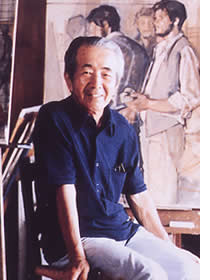ホーム > 文化・スポーツ > 文化施設 > 神戸市立小磯記念美術館 / KOISO MEMORIAL MUSEUM OF ART > 神戸市立小磯記念美術館:小磯良平 紹介
神戸市立小磯記念美術館:小磯良平 紹介
最終更新日:2024年1月26日
ここから本文です。
>年譜
プロフィール / About KOISO Ryohei

![]()
小磯良平は親しみやすい女性像を中心としながら、西洋絵画の伝統の中に、市民的でモダンな感覚と気品あふれる画風を完成した画家でした。
小磯は、1903年、旧三田九鬼藩の旧家で、貿易に携わっていた岸上家の8人兄弟姉妹の次男として、神戸市神戸(現中央区)の中山手通7丁目に生まれました。当時の神戸は、外国貿易の窓口となっていた旧外国人居留地を中心に発展しており、小磯は洋館が立ち並ぶ街で自然に「西洋的な空気」を吸って幼年期を送りました。クリスチャンの家庭で育ち、鉛筆と紙を与えておけば黙々と絵を描いて飽きることがなかったといいます。
小磯は兵庫県立第二神戸中学校(現 兵庫高校)に進学し、生涯の親友となった竹中郁と出会います。のちに神戸を代表するモダニスト詩人となる竹中の影響もあり、小磯の心の眼はヨーロッパに向けて開かれました。大正10年(1921)、倉敷へ一緒に出かけ、大原コレクションを公開した「現代フランス名画家作品展覧会」に感動を覚え、画家への志しを強めます。
1922年、小磯は東京美術学校(現東京藝術大学)の西洋画科に入学し、猪熊弦一郎・岡田謙三・荻須高徳ら優秀な同級生と画架を並べることになります。持ち前の実直さで努力を重ねた結果、1925年の帝展(帝国美術院美術展覧会)に入選を果たし、翌年には『T嬢の像』(兵庫県立美術館蔵)が特選に輝きます。このことを竹中は「当時在学中に特選に遇されることは異例といってよいほど珍しい。小磯という姓を審査員の誰も知らなかったので特選になったわけで、もし旧姓の岸上ならば早すぎると判断されてしまったかも知れない…という噂があった」と記しています。当時、美術学校では出品を禁じていましたが、23歳の画学生が描いたとは思えない完成度の高さを誇るこの作品で、小磯は画壇に鮮烈なデビューを果たしたのです。
1927年、規定課題の『自画像』(東京藝術大学大学美術館蔵)、竹中郁をモデルにした『彼の休息』(東京藝術大学大学美術館蔵)の2作品で98点という最高得点をとり、首席で卒業しました。
その翌年、小磯は念願であったフランス留学に出発し、一足先に到着していた竹中とともに2年間ヨーロッパを遊学します。絵画技法の習得よりも、各地の美術館をめぐり、アングル、コロー、クールベ、マネ、ドガなどの巨匠達の作品を鑑賞することに熱心でした。時には劇場で踊り子たちの舞う姿を楽しみ、クラシックの音色に耳を傾けたようです。
神戸に戻ってからの小磯は、精力的に絵筆を振るい始めます。優れた素描力を十分に生かしながら、「欧州絵画の古典的な技法を日本の洋画に根付かせる」ための研究を根気強く続け、独自の画境を開くことになります。また母校の教授として、東京芸術大学で教鞭をとり、画学生たちの若い感性を大切にした指導で、日本の洋画界に大きく貢献しました。
※English
KOISO Ryohei is a Western-style painter who completed modern sense and elegant style in the tradition of Western painting, focusing on the familiar image of women.
KOISO was born in 1903 in Nakayamatedori 7-chome, Kobe (currently Chuo-ku), Kobe City, as the second son of eight brothers and sisters of the Kishigami family who were involved in trade in the former family of the former Sanda Kuki clan. At that time, Kobe was developing around the former foreign settlement, which was the window for foreign trade, and KOISO spent his childhood, naturally breathing "Western air" with Western-style houses. He grew up in a Christian family, and when he was given a pencil and paper, he was silently drawing and wouldn't get tired of it.
KOISO studied at Hyogo Prefectural Second Kobe Junior High School under the former educational system (currently Hyogo High School) and met TAKENAKA Iku, who became his lifelong best friend. With the influence of TAKENAKA, who later became a modernist poet representing Kobe, KOISO's eyes were opened to Europe. In 1921, he went to Kurashiki with TAKENAKA and was impressed by the "Exhibition of Contemporary French Master Painters" that exhibited the Ohara collection, and strengthened his aspirations to become a painter.
In 1922, KOISO enrolled in the Western Painting Department of Tokyo Fine Arts School (currently Tokyo University of the Arts), and worked hard and encourage each other with excellent classmates such as INOKUMA Genichiro, OKADA Kenzo, and OGUISS Takanori. As a result of strenuous efforts with his own honesty, he was selected for the Imperial Exhibition (Imperial Art Academy Art Exhibition) in 1925, and the following year, "Figure of Miss T" (Hyogo Prefectural Museum of Art) shined as the highest honor. TAKENAKA mentioned, "It is unusual to be treated as the highest honor while attending school at that time. Since none of the judges knew the surname KOISO, it was selected as the highest honor. There were rumors that it might have been judged that it was too early for him to get the prize if he applied his work with his former surname “KISHIGAMI”. ” At that time, students were forbidden to apply for the Imperial Exhibition, but KOISO made a brilliant debut in the art world with this work, which boasts a high degree of perfection that cannot be imagined drawn by a 23-year-old art student.
In 1927, KOISO obtained the highest score of 98 points for two works, "Self-portrait" (Tokyo University of the Arts, University Art Museum) and "His Rest" (Tokyo University of the Arts, University Art Museum) modeled on TAKENAKA Iku, and graduated at the top. The following year, he set out to study abroad in France, which he had longed for, and traveled to Europe for two years with TAKENAKA, who had arrived a little earlier. Rather than mastering painting techniques, he was enthusiastic about visiting museums around the world and appreciating the works of masters such as Ingles, Corot, Courbet, Manet, and DEGAS. Sometimes he enjoyed the ballet performances in the theater and listened to the classical music.
After returning to Kobe, he energetically began to work on his production. While making full use of his excellent drawing skills, he continued his research to "root the classical techniques of European painting in Japanese Western-style paintings" and opened up his own painting boundaries. Also, as a professor at his alma mater, he taught at Tokyo University of the Arts and made a great contribution to the Western painting world in Japan by giving guidance that respects the young sensibilities of art students.